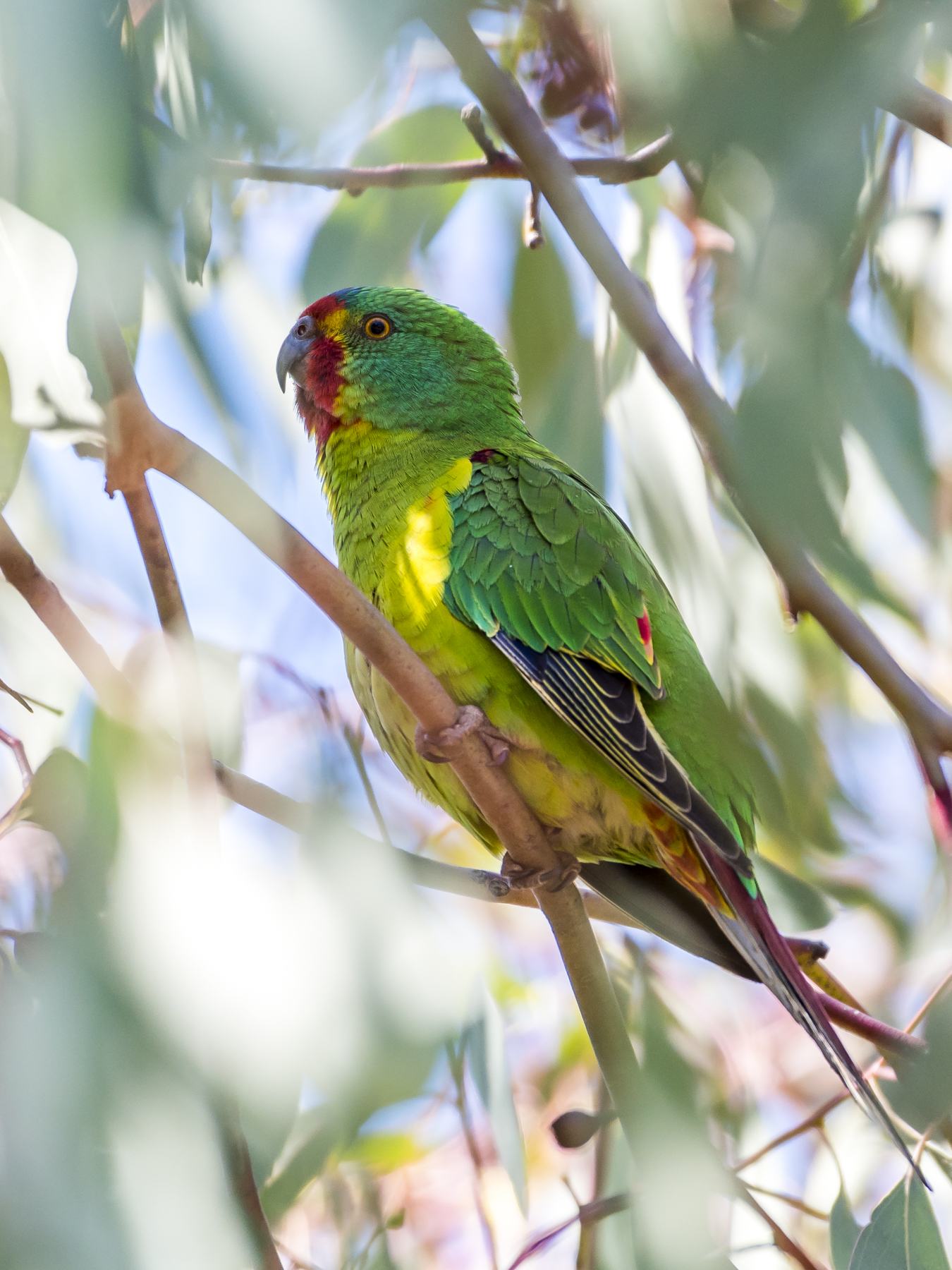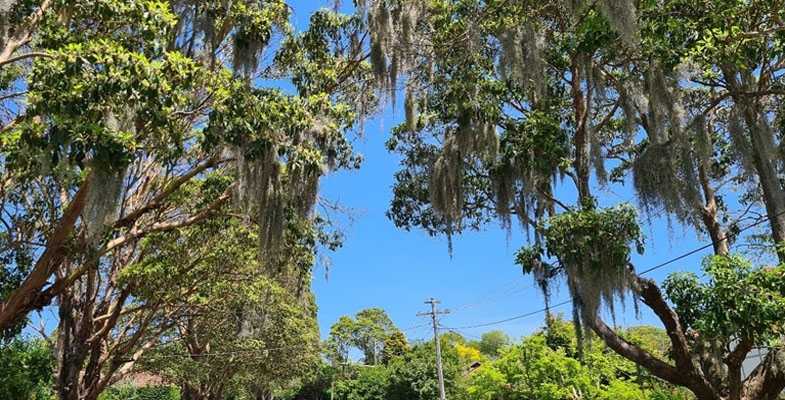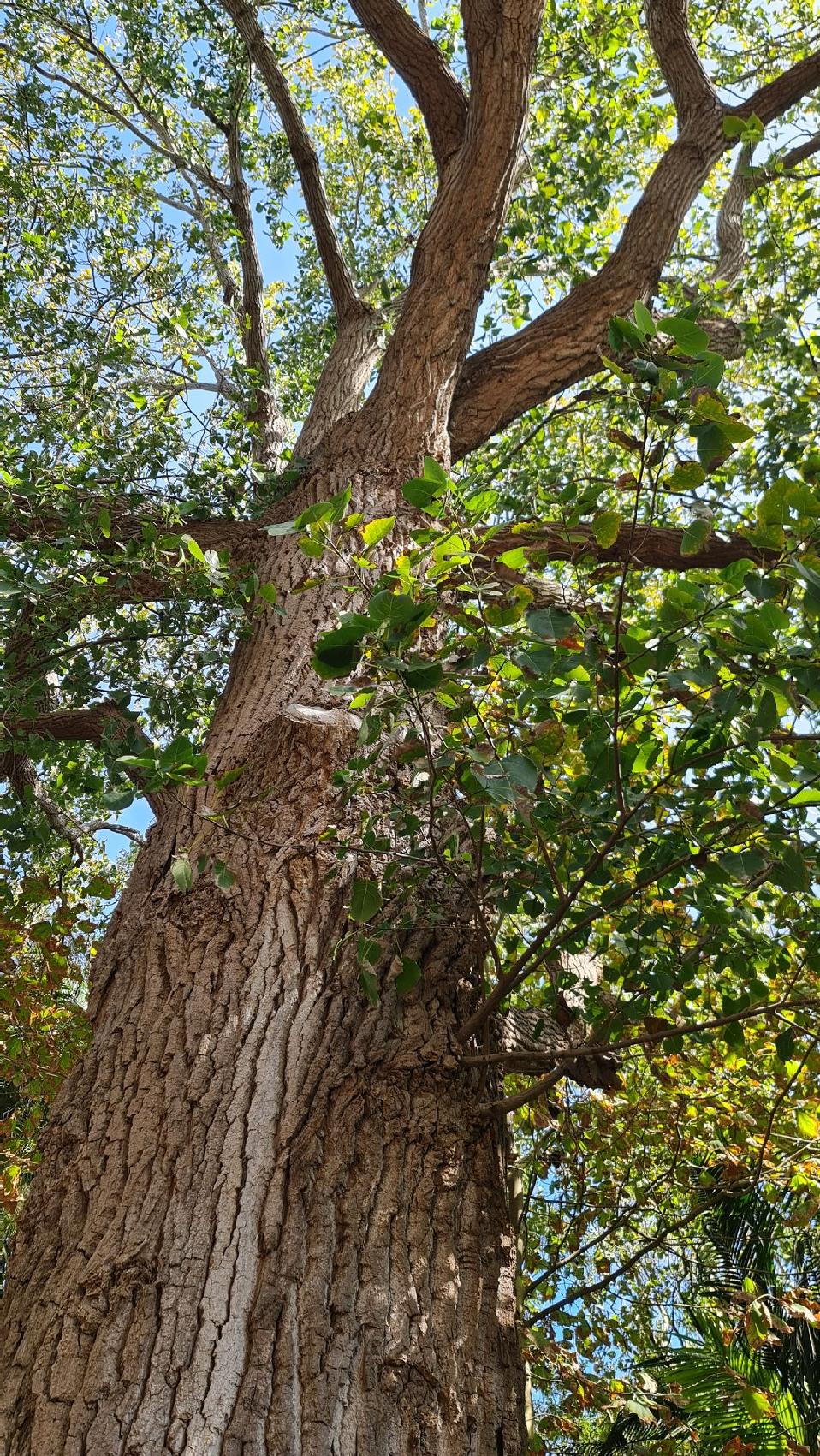Currently flowering: Swamp Mahogany - Eucalyptus Robusta
Tree that grows to 30 m high; bark persistent, red-brown, stringy (shortly fibrous), thick and spongy. Juvenile leaves disjunct, ovate, glossy green.
Adult leaves disjunct, broad-lanceolate, 10–17 cm long, 2–4.5 cm wide, dark green, glossy, discolorous, penniveined. Umbellasters 7- to > 11-flowered; peduncle broadly flattened, 13–30 mm long; pedicels terete, 1–9 mm long. Buds fusiform, 16–24 mm long, 6–8 mm diam., scar present; calyptra elongate acute or rostrate, as long and as wide as hypanthium.
Fruit cylindrical, 10–18 mm long, 6–11 mm diam.; disc depressed; valves rim-level or slightly exserted, usually apically joined.
Origin of Name: Eucalyptus robusta: Latin robustus, robust, referring to the appearance of the trees.
Flowering has been recorded in April, May, July, August, September, and October.
The timber of E. robusta has been used for fencing and wharf construction. The species is also used for honey production, and sometimes grown as an ornamental or windbreak tree.
A small to medium-sized tree of coastal New South Wales from about Moruya north to north-west of Bundaberg in south-eastern Queensland, including North Stradbroke, Moreton and Fraser Islands. One of the red mahoganies, E. robusta is recognised by the thick fibrous rough bark, large, discolorous leaves with wide-angled side-veins, large buds and cylindrical fruit with the valves of the fruit remaining joined across the orifice, with this latter feature being unique in eucalypts in eastern Australia. Eucalyptus robusta usually occurs in swampy sites.
Eucalyptus robusta belongs in Eucalyptus subgenus Symphyomyrtus section Latoangulatae because cotyledons are bilobed, leaves are discolorous and have side-veins at a wide angle to the midrib and buds have two opercula. Within this section, E. robusta is one of seven species forming series Annulares (the red mahogany group), as it has ovules in (6)8 rows, seeds pyramidal and bark rough over the trunk. The other six species are E. pellita, from coastal north Queensland and New Guinea; E. urophylla, from Timor and other islands to the north-west of Australia; E. scias, (with two subspecies) scattered in coastal and subcoastal New South Wales; E. notabilis, scattered in coastal and subcoastal New South Wales and south-eastern Queensland; E. resinifera, (with two subspecies) widespread in coastal New South Wales and Queensland; and E. botryoides, from coastal eastern Victoria and southern New South Wales.
Information sourced from EUCILD - Eucalypts of Australia: apps.lucidcentral.org/euclid/text/intro
Specimens of E. robusta were first collected by First Fleet surgeon and naturalist John White, and the species description was published by James Edward Smith in his 1793 collaboration with George Shaw, Zoology and Botany of New Holland. Shortly afterwards, the description was reprinted verbatim in Smith's A Specimen of the Botany of New Holland, and it is this publication that is usually credited. Smith gave it the specific epithet robusta ("robust") in reference to the size and strength of the full-grown tree. The common name of swamp mahogany comes from its preferred habitat of swamps, and its timber's likeness to that of West Indies mahogany (Swietenia mahagoni). Eucalyptus robusta is known as the swamp messmate in Queensland.
.jpg?timestamp=1745435570378)
E. robusta by James Sowerby, from James Edward Smith's 1793 A Specimen of the Botany of New Holland
The species has been formally assessed for the IUCN Red List as "Near Threatened (NT)" as its population is thought to have declined by 25.7% over the previous three generations. The species has lost much of its habitat to urbanisation and land-clearing for agriculture and much of what is left is highly fragmented.
A long-lived tree, Eucalyptus robusta can live for at least two hundred years. Trees regenerate by regrowing from epicormic buds on the trunk after bushfire.
The grey-headed flying fox (Pteropus poliocephalus) eats the flowers, and the koala (Phascalarctos cinereus) eats the leaves. The musk lorikeet feeds on the nectar of the blossoms. It is a favoured tree species of the critically endangered swift parrot on the mainland. It is a keystone species on the New South Wales Central Coast and Illawarra regions, where it is one of few reliable winter-flowering plants.
Musk Lorikeet, Pittwater. Photo: A J Guesdon
Scaly-breasted Lorikeet, Pittwater. Photo: A J Guesdon

Stands of E. robusta have been drastically reduced by land clearance. Some remnant trees in Robson Park in the Sydney suburb of Haberfield are the last vestiges of the Sydney Coastal Estuary Swamp Forest Complex community in Sydney's inner western suburbs. Warriewood valley and Warriewood wetlands in Pittwater are also home to stands of these trees.
Insects, such as psyllids and Christmas beetles from the genus Anoplognathus and the eucalyptus chafer (Xylonichus eucalypti) commonly eat the leaves. The rectangular-lerp forming psyllid Glycaspis siliciflava eats only this species. The scale insects Brachyscelis munita and Opisthoscelis pisiformis form galls. The adult double drummer cicada (Thopha saccata) lives in the tree, while larvae of the small staghorn beetle species Ceratognathus froggattii and another beetle Moechidius rugosus live and pupate within the thick bark. The wood-moth (Aenetus splendens) makes a thick bag-like structure around a branch where it breeds.
While Eucalyptus robusta (Swamp Mahogany) itself is not listed as critically endangered in NSW, the River-Flat Eucalypt Forest on Coastal Floodplains, where it is a key component, is. This ecological community is listed as Critically Endangered under both the NSW Threatened Species Conservation Act 1995 and the Commonwealth Environment Protection and Biodiversity Conservation Act 1999, indicating a severe threat to its survival.
Bioregions: This ecological community is found in the NSW North Coast, Sydney Basin, and South East Corner bioregions.
Keystone Species: Eucalyptus robusta (Swamp Mahogany) is a prominent species within this forest type, but the entire ecological community is the focus of conservation efforts.
Eucalyptus robusta (Swamp Mahogany) is closely related to Sydney Turpentine, both belonging to the Myrtaceae family. They are found in similar habitats, often in coastal areas and on moist soils, but their distributions and specific characteristics differ.
The Sydney Turpentine-Ironbark Forest (STIF), often found in areas like St. Ives (you can see them along the Mona Vale road heading east to Mona Vale and all along Burrawong road at North Avalon), is another critically endangered ecological community. It's protected under both the NSW Biodiversity Conservation Act 2016 and the Commonwealth Environment Protection and Biodiversity Conservation Act 1999. This means the forest is facing a high risk of extinction in the immediate future. It's a critically endangered ecological community due to land clearing and habitat degradation, such as invasive weeds.
Syncarpia glomulifera in Burrawong road, North Avalon, April 24, 2025
Spanish Moss killing critically endangered local trees
The spread of environment weeds in Pittwater is becoming of greater concern to residents and the bushcarers who work to remove them. A recent pictorial by Joe Mills showed there is widespread masses of all types of weeds at Warriewood's perimeter and wetlands and the spread of Spanish Moss, with quite a bit now growing on trees beside the path into Toongari Reserve off Avalon Parade, next to the kindergarten, is yet another invader.
Spanish Moss has been found to spread over mature trees across the Sydney Basin and in doing so, prevent photosynthesis, killing the trees.
A recent study by STEP, over Cowan to Marrickville, ascertained what tree species it grew on and found the critically endangered Turpentine (Syncarpia glomulifera) is the most severely affected of all the 76+ species of plants STEP recorded Spanish Moss growing in.
Fragments carried by birds to line nests in bushland have spread this weed into more and more areas, but the tips can also be blown by the wind to another plant.
See: https://www.step.org.au/index.php/item/702-spanish-moss-a-serious-environmental-weed
STEP is a community-based environmental organisation with over 500 members from Ku-ring-gai, Hornsby and surrounding suburbs. Our primary aim is to work for the conservation of bushland in northern Sydney.
Many of these are termed 'garden escapees'.
STEP's Recommendations:
- Gardeners remove all moss they can reach, put it in their green bin and prevent spread.
- Local authorities such as local councils and NPWS remove it from all public places, including trees on nature strips.
- Add Spanish Moss to the next iteration of the Greater Sydney Regional Strategic Weed Management Plan and all other relevant regional strategic weed management plans.
- Classify Spanish Moss at a level that enables its eradication and containment, prohibition of sale and distribution, e.g. as a regional priority weed.
- Undertake research into why Turpentines are a favoured host and the ecological effects of Spanish Moss on bushland.
- Undertake research into control methods.
Swaying veils of grey in dead or dying trees and simplified bushland is not something to look forward to. Let’s not risk it.
Read STEP's full report.

Spanish Moss infestation killing Australian trees: STEP photo
